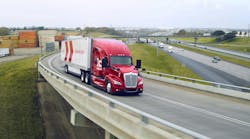Even as opposition grows in many part of the country toward privatizing public toll roads as well as adding new taxes to help raise desperately needed cash to build and maintain highways, many states are finding they have few funding alternatives.
“Even with cost-saving efficiencies implemented over the last two years, 36% inflation in construction costs has threatened to undermine our ability to build smoother pavements and tackle a multi-billion dollar bridge backlog,” said Pennsylvania Governor Edward Rendell (D). “While we need to develop a solution that has the least impact on the people of Pennsylvania, keep in mind we must make critical transportation funding choices or face the real possibility of a transportation crisis of devastating proportions.”
To provide a $1.7-billion package to provide funds for road projects as well as public transit services, Rendell is proposing to lease the Pennsylvania Turnpike to a private consortium in a deal that would produce as much as $965 million a year for the state’s transportation needs. He also wants to levy a new 6.17% gross profits tax on oil companies that do business in Pennsylvania starting March 2008 – that would generate another $760 million a year.
He said those funds would enable Pennsylvania’s Department of Transportation to: aggressively reduce the critical bridge backlog and more quickly eliminate structurally deficient bridges; bring smoother pavements to the lowest-volume roads, 32% of which are in poor condition; and allow public transit to gain a firmer financial footing, meaning increased investment in vehicles and equipment to better attract and keep riders.
The Transportation for Illinois Coalition (TFIC) is following in Pennsylvania’s footsteps as it is calling on the Illinois government to invest $25 billion in road projects and public transit over the next five years – including $1.8 billion for state highways and $340 million for local roads.
“If we don’t act … the past few years of declining investment in our transportation infrastructure will put out of reach the possibility of adequately maintaining and enhancing our highway, transit, rail and air network,” said Illinois State Chamber of Commerce president Doug Whitley, who helps chair the TFIC.
“To deliver a transportation funding package that will address the real need for investment in Illinois' highways and bridges, transit systems, freight and passenger rail systems and small airports, new revenue is necessary,” he added. “Failure to plan transportation and land use region-wide can impede a critical asset – transportation – and the overall result would be slower growth in the regional economy.”
Still, trying to find the funds to jump-start these kinds of massive road infrastructure projects is creating a great deal of political friction.
In Virginia, for example, state assembly leaders have been at loggerheads for two years over how to come up with $2 billion in proposed road funding. This year, a plan to partially fund that program using $250 million in funds cut from the state’s education budget was scuttled. The same fate hangs over a plan to raise $330 million by charging a $150 registration fee on new and used vehicles – along with a regional 10-cent tax on real estate deals, 1.5 cent hike in diesel fuel taxes, and other fees.
The key, said State Representative John Chichester (R), chairman of the state’s finance committee, is to isolate general revenue finds from transportation needs. Otherwise, he contends, in the future Virginia could be forced to cut spending on crucial services to pay for highways and mass transit. “If you think we’ve solved transportation [with these plans], you’re wrong,” Chichester told the Richmond Times Dispatch newspaper.


